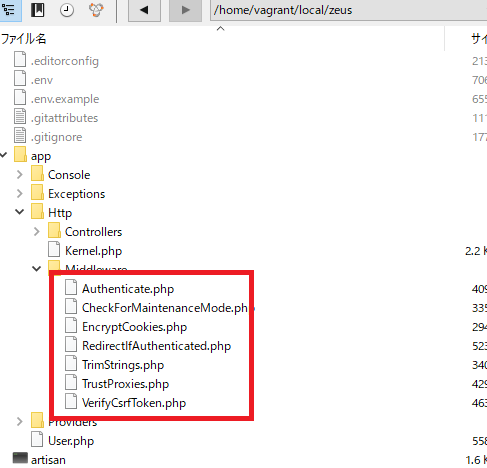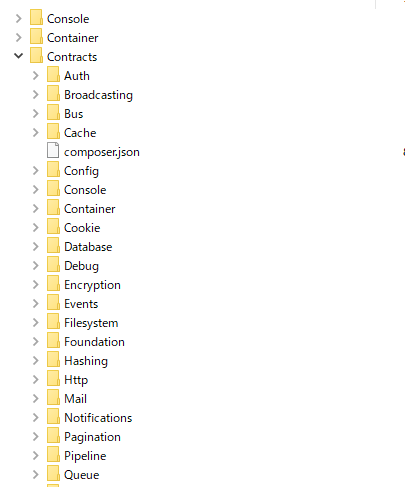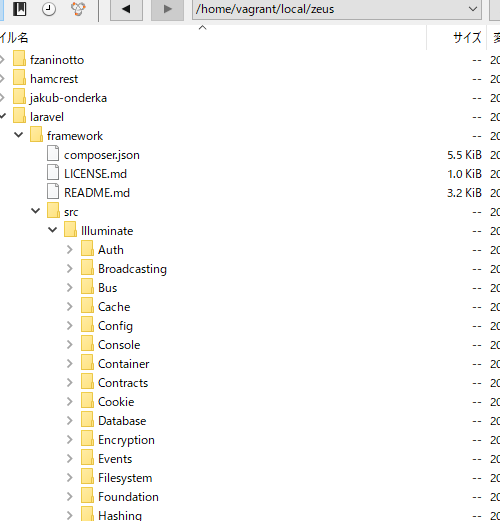さー楽しくなってきました。
なんかRoutingって面白いんだが、俺だけ?
Route::get('foo', function () {
return 'Hello World';
});
/fooがきたらhello world!
All Laravel routes are defined in your route files, which are located in the routes directory. These files are automatically loaded by the framework. The routes/web.php file defines routes that are for your web interface. These routes are assigned the web middleware group, which provides features like session state and CSRF protection. The routes in routes/api.php are stateless and are assigned the api middleware group.
routes/web.phpが基本。中を見てみましょう。stringではなく、view(‘welcome’)です。
Route::get('/', function () {
return view('welcome');
});
api.php
Route::middleware('auth:api')->get('/user', function (Request $request) {
return $request->user();
});
Route::middlewareの意味が解ん。
channel.php
Broadcast::channel('App.User.{id}', function ($user, $id) {
return (int) $user->id === (int) $id;
});
broadcastの意味が。。。
console.php
Artisan::command('inspire', function () {
$this->comment(Inspiring::quote());
})->describe('Display an inspiring quote');
consoleに至ってはArtisanときたか。
userControllerをひっぱる場合
Route::get('/user', 'UserController@index');
あーこれこれ、やっときた。
Routes defined in the routes/api.php file are nested within a route group by the RouteServiceProvider. Within this group, the /api URI prefix is automatically applied so you do not need to manually apply it to every route in the file. You may modify the prefix and other route group options by modifying your RouteServiceProvider class.
Available Router Methods
The router allows you to register routes that respond to any HTTP verb:
Route::get($uri, $callback);
Route::post($uri, $callback);
Route::put($uri, $callback);
Route::patch($uri, $callback);
Route::delete($uri, $callback);
Route::options($uri, $callback);
putってなんだっけ?他はイメージできる。
Sometimes you may need to register a route that responds to multiple HTTP verbs. You may do so using the match method. Or, you may even register a route that responds to all HTTP verbs using the any method:
Route::match(['get', 'post'], '/', function () {
//
});
Route::any('foo', function () {
//
});
こんなのできんだーすげー
CSRF Protection
Any HTML forms pointing to POST, PUT, or DELETE routes that are defined in the web routes file should include a CSRF token field. Otherwise, the request will be rejected. You can read more about CSRF protection in the CSRF documentation:
<form method="POST" action="/profile">
@csrf
...
</form>
確かlaravelはcsrfを自動でやってくれるんだっけ。
Redirect Routes
If you are defining a route that redirects to another URI, you may use the Route::redirect method. This method provides a convenient shortcut so that you do not have to define a full route or controller for performing a simple redirect:
Route::redirect('/here', '/there', 301);
routingのドキュメント読んでると、イメージが湧いてきた。
If your route only needs to return a view, you may use the Route::view method. Like the redirect method, this method provides a simple shortcut so that you do not have to define a full route or controller. The view method accepts a URI as its first argument and a view name as its second argument. In addition, you may provide an array of data to pass to the view as an optional third argument:
Route::view('/welcome', 'welcome');
Route::view('/welcome', 'welcome', ['name' => 'Taylor']);
Required Parameters
Of course, sometimes you will need to capture segments of the URI within your route. For example, you may need to capture a user’s ID from the URL. You may do so by defining route parameters:
Route::get('user/{id}', function ($id) {
return 'User '.$id;
});
{id}は絶対使う。
Route::get('posts/{post}/comments/{comment}', function ($postId, $commentId) {
//
});
Route parameters are always encased within {} braces and should consist of alphabetic characters, and may not contain a – character. Instead of using the – character, use an underscore (_). Route parameters are injected into route callbacks / controllers based on their order – the names of the callback / controller arguments do not matter.
Occasionally you may need to specify a route parameter, but make the presence of that route parameter optional. You may do so by placing a ? mark after the parameter name. Make sure to give the route’s corresponding variable a default value:
Route::get('user/{name?}', function ($name = null) {
return $name;
});
Route::get('user/{name?}', function ($name = 'John') {
return $name;
});
条件判定もできる模様
You may constrain the format of your route parameters using the where method on a route instance. The where method accepts the name of the parameter and a regular expression defining how the parameter should be constrained:
Route::get('user/{name}', function ($name) {
//
})->where('name', '[A-Za-z]+');
Route::get('user/{id}', function ($id) {
//
})->where('id', '[0-9]+');
Route::get('user/{id}/{name}', function ($id, $name) {
//
})->where(['id' => '[0-9]+', 'name' => '[a-z]+']);
あーいいね、好きだわこれ。
Global Constraints
If you would like a route parameter to always be constrained by a given regular expression, you may use the pattern method. You should define these patterns in the boot method of your RouteServiceProvider:
/**
* Define your route model bindings, pattern filters, etc.
*
* @return void
*/
public function boot()
{
Route::pattern('id', '[0-9]+');
parent::boot();
}
Route::get('user/{id}', function ($id) {
// Only executed if {id} is numeric...
});
Named Routes
Named routes allow the convenient generation of URLs or redirects for specific routes. You may specify a name for a route by chaining the name method onto the route definition:
あれ、なにこれ。こんなのあったっけ。
Route::get('user/profile', function () {
//
})->name('profile');
Route::get('user/profile', 'UserProfileController@show')->name('profile');
Generating URLs To Named Routes
Once you have assigned a name to a given route, you may use the route’s name when generating URLs or redirects via the global route function:
// Generating URLs...
$url = route('profile');
// Generating Redirects...
return redirect()->route('profile');
If the named route defines parameters, you may pass the parameters as the second argument to the route function. The given parameters will automatically be inserted into the URL in their correct positions:
Route::get('user/{id}/profile', function ($id) {
//
})->name('profile');
$url = route('profile', ['id' => 1]);
Route groups allow you to share route attributes, such as middleware or namespaces, across a large number of routes without needing to define those attributes on each individual route. Shared attributes are specified in an array format as the first parameter to the Route::group method.
To assign middleware to all routes within a group, you may use the middleware method before defining the group. Middleware are executed in the order they are listed in the array:
Route::middleware(['first', 'second'])->group(function () {
Route::get('/', function () {
// Uses first & second Middleware
});
Route::get('user/profile', function () {
// Uses first & second Middleware
});
});
ほーmiddlewareだとgroupingですな。
Another common use-case for route groups is assigning the same PHP namespace to a group of controllers using the namespace method:
controllerのnamespaceで制御するのか。
Route::namespace('Admin')->group(function () {
// Controllers Within The "App\Http\Controllers\Admin" Namespace
});
Remember, by default, the RouteServiceProvider includes your route files within a namespace group, allowing you to register controller routes without specifying the full App\Http\Controllers namespace prefix. So, you only need to specify the portion of the namespace that comes after the base App\Http\Controllers namespace.
Sub-Domain Routing
Route groups may also be used to handle sub-domain routing. Sub-domains may be assigned route parameters just like route URIs, allowing you to capture a portion of the sub-domain for usage in your route or controller. The sub-domain may be specified by calling the domain method before defining the group:
あれ、subdomainってDNS側の設定がいるんじゃなかったっけ?つまり、DNS側の設定をしておけば、routingで簡単にサブドメインにも適用できるってこと? これはちょっとやりたいです。
Route::domain('{account}.myapp.com')->group(function () {
Route::get('user/{id}', function ($account, $id) {
//
});
});
Route Prefixes
The prefix method may be used to prefix each route in the group with a given URI. For example, you may want to prefix all route URIs within the group with admin:
Route::prefix('admin')->group(function () {
Route::get('users', function () {
// Matches The "/admin/users" URL
});
});
あんまり使わないような。というかこれ、基礎!? 他のフレームワークに応用できるんかいな。
Route Name Prefixes
The name method may be used to prefix each route name in the group with a given string. For example, you may want to prefix all of the grouped route’s names with admin. The given string is prefixed to the route name exactly as it is specified, so we will be sure to provide the trailing . character in the prefix:
Route::name('admin.')->group(function () {
Route::get('users', function () {
// Route assigned name "admin.users"...
})->name('users');
});



